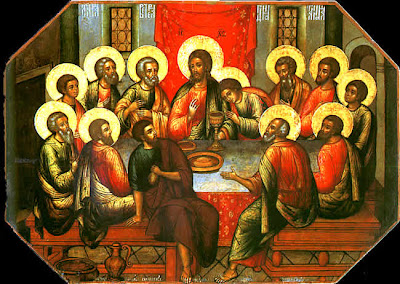On Holy Thursday morning there is a special Mass in Cathedral Churches, celebrated by the bishop and as many priests of the diocese as can attend, because it is a solemn observance of Christ's institution of the priesthood at the Last Supper. At this "Chrism Mass" the bishop also blesses the Oil of Chrism used for Baptism, Confirmation and Anointing of the sick or dying. The bishop may wash the feet of twelve of the priests, to symbolize Christ's washing the feet of His Apostles, the first priests.
The evening Holy Thursday Liturgy, marks the end of Lent and the beginning of the sacred "Triduum" ("three days") of Holy Week, which culminates in the Easter Vigil, and concludes at Vespers on the evening of Easter day (see Paschalis Sollemnitatis, §§ 38-40). The Mass begins in the evening, because Passover began at sundown; it commemorates Our Lord's institution of the Holy Eucharist at the Last Supper. It also shows both the worth God ascribes to the humility of service, and the need for cleansing with water (a symbol of baptism) in the Mandatum, washing, commemorating Jesus' washing the feet of His apostles, as well as in the priest's stripping and washing of the altar. Cleansing, in fact, gave this day of Holy Week the name Maundy Thursday.
The action of the Church on this night also witnesses to the Church's esteem for Christ's Body present in the consecrated Host in the Adoration of the Blessed Sacrament, carried in solemn procession to the flower-bedecked Altar of Repose, where it will remain "entombed" until the communion service on Good Friday. No Mass will be celebrated again in the Church until the Easter Vigil proclaims the Resurrection.
And finally, there is the continued Adoration of the Blessed Sacrament by the people during the night, just as the disciples stayed with the Lord during His agony on the Mount of Olives before the betrayal by Judas.
There is such an abundance of symbolism in the solemn celebration of the events of Holy Thursday layer upon layer, in fact that we can no more than hint at it in these few words. For many centuries, the Last Supper of Our Lord has inspired great works of art and literature, such as the glorious stained glass window in Chartres cathedral (above), Leonardo's ever popular (and much imitated) Last Supper in the 16th century; and a reminiscence called Holy Thursday, by the French novelist François Mauriac, written in the 1930s. (A chapter of Mauriac's meditation was reprinted in Voices, Lent-Easter 2002, with permission from Sophia Institute Press).

No comments:
Post a Comment